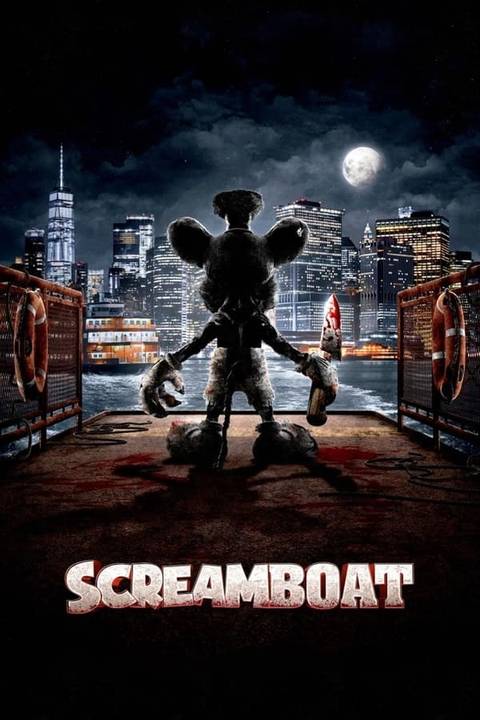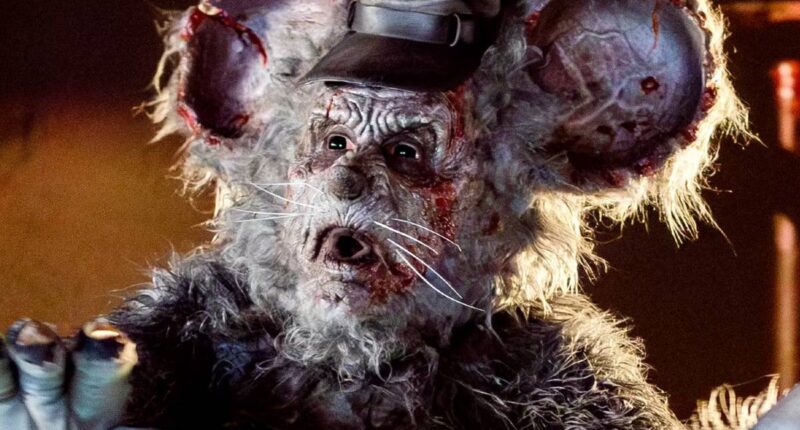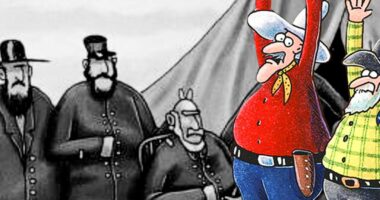David Howard Thornton has made his name by embodying one of horror’s most chilling creations: Art the Clown from Damien Leone’s Terrifier films. Silent, sadistic, and soaked in blood, Art vaulted from cult obscurity into modern horror legend, transforming Thornton into the face of a franchise that thrives on pushing audiences to their limits. But Screamboat, a 2025 parody of Disney’s most beloved rodent, lasers in on a very different side of the actor — one that’s equally committed, unhinged, and surprisingly hilarious.
Let’s be clear: Screamboat is not a great movie. It’s the kind of shaggy, gleefully chaotic parody that feels stitched together more like a midnight sketch than a polished feature. But within that messy experiment lies Thornton’s secret weapon: his ability to channel the same energy that made Art the Clown terrifying (and yet to some oddly endearing) and twist it into something uproariously funny.
A Horror Icon in Cartoon Clothing
What makes Thornton’s performance fascinating is how little he changes his toolkit. As Art, his performance is defined by exaggerated physicality, unpredictable timing, and the unnerving commitment to staying silent while everything around him spirals into carnage. In Screamboat, he applies those same traits to Mickey Mouse as “Steamboat Willie,” but instead of terrorizing victims, he terrorizes the very idea of wholesome cartoon innocence. Every twitch, gesture, and dead-eyed smile echoes the physical discipline he brought to Art the Clown. But now, that menace mutates into comedy. When Mickey’s famous whistling is reduced to awkward silence, or when his bouncy movements become sharp, jagged stabs of motion, the effect is both grotesque and hilarious — a funhouse mirror version of Disney’s icon. Thornton isn’t mocking Mickey so much as bending him until he breaks, the way he’s always bent Art until the horror curdled into something unforgettable.
It’s a reminder of how porous the line between horror and comedy really is. Both rely on timing, misdirection, and a willingness to lean into the absurd, and Thornton understands this instinctively. He doesn’t wink at the audience or soften the parody; he commits to it with the same dangerous glee that made audiences afraid of Art’s smile.
Even When the Film Sinks, Thornton Stays Afloat
For all of Thornton’s brilliance, Screamboat itself often stumbles. The film plays like a feature-length sketch, its parody stretched thin across a runtime that feels longer than it is. Jokes repeat, pacing wobbles, and its anarchic energy sometimes collapses into incoherence. In short: it sinks. And yet, Thornton never goes under with it. He remains hypnotic, pulling laughs even when the surrounding material flounders. That’s the mark of a true cult performer — someone who can thrive in uneven projects by sheer force of presence. Audiences may forget Screamboat as a whole, but they won’t forget the sight of Thornton twisting Mickey Mouse into something at once grotesque, funny, and strangely endearing.
Thornton’s willingness to throw himself into something as oddball as Screamboat says as much about his career as Terrifier does. Cult horror stars rarely rise on prestige or polish; they rise because they embrace extremes. Think Bruce Campbell hurling himself through slapstick gore in Evil Dead 2, or Robert Englund turning Freddy Krueger into both nightmare and punchline. Thornton follows that lineage. By taking on a project that most actors might dismiss as beneath them, he reinforces what makes cult icons endure: a refusal to play it safe. Screamboat may never be mentioned alongside awards-season fare, but it will linger in the memory of anyone who sees it because Thornton makes it impossible to look away. He treats Mickey Mouse the way he treats Art the Clown: as a canvas for physical comedy, unsettling energy, and a level of commitment that turns even absurd material into something magnetic.
Thornton’s Future Lies in Extremes
The question isn’t whether Screamboat will expand Thornton’s audience (it probably won’t) but what it signals about his career arc. Rather than being boxed into Art the Clown forever, he’s proving he can weaponize that same silent menace across genres. If Art made him infamous, Mickey makes him unpredictable. That unpredictability is exactly what keeps cult stars relevant long after mainstream attention moves on. And let’s not undersell the comedy. Thornton isn’t just funny in Screamboat; he’s hilarious in a way that feels both intentional and dangerous. He’s not cracking jokes — he’s embodying them, bending his body and timing into something absurd. It’s not safe humor. It’s humor with teeth, the kind that threatens to bite at any moment. That’s the same edge that made Art the Clown terrifying, now repurposed for parody.
Screamboat won’t redefine parody cinema, and it may not even satisfy most audiences who stumble into it expecting a polished send-up. But what it does deliver is a showcase of Thornton’s sheer malleability as a performer. He doesn’t abandon what made him famous; he repurposes it. The silence, the physicality, the unpredictability — all of it carries over from Terrifier into Screamboat, only twisted into hilarity instead of outright horror. The film may wobble, drift, and eventually sink, but Thornton never does. He proves once again that cult stardom isn’t about perfection; it’s about commitment, extremity, and the ability to transform even flawed material into something unforgettable. His version of Mickey may not be Disney-approved, but Thornton shows that parody can be just as powerful as pixie dust.
Screamboat is now available to stream on Peacock in the U.S.

- Release Date
-
January 31, 2025
- Director
-
Steven LaMorte
-

David Howard Thornton
Steamboat Willie
-

Jesse Kove
Lieutenant Diaz










